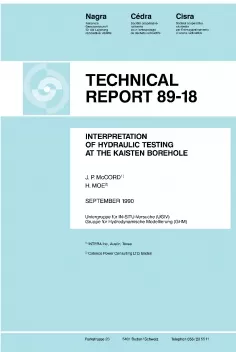
Technical Report NTB 89-18
Interpretation of hydraulic testing at the Kaisten borehole
This report presents the results of hydrogeologic interpretations of the analyzable single packer, double packer, and H-log tests conducted in the Kaisten borehole. A brief discussion of the testing and interpretation methods is also presented. Data analysis was performed using the INTERA Graph Theoretic Field Model (GTFM) which permits borehole pressure history and thermally-induced pressure effects to be incorporated into the simulations.
Formation pressures (and corresponding equivalent freshwater heads) were determined for nine of the test intervals. The calculated equivalent freshwater heads were at 296.8 m a.s.l. (Buntsandstein) and 323.7 m a.s.l. (Permian) for the sedimentary units. For the upper crystalline, the calculated freshwater heads were at 322.5 m a.s.l. at a depth of 310.38 m, and at 324.6 m a.s.l. at a depth of 482.50 m. For the lower crystalline, from 818.86 m to 1'275.60 m depth, the calculated freshwater heads ranged from 345.8 m a.s.l. to 351.0 m a.s.l.
Hydraulic conductivities were estimated for 53 different hydraulic test sequences in the Kaisten borehole. Interpreted hydraulic conductivities ranged from greater than 1.0E-06 ms-1 to less than 1.0E-12 ms-1. Approximately 60 % of the test intervals exhibited hydraulic conductivities greater than or equal to 1.0E-09 ms-1. These high hydraulic conductivity intervals are distributed throughout the borehole. The longest section of the borehole exhibiting intermediate to low hydraulic conductivities (less than 1.0E-10 ms-1) is 137 m between the approximate depths of 666 m and 803 m. A base case specific storage of 2.1E-08 m-1 was used for the analyses in the crystalline rock. In several cases, sensitivity analyses were conducted to determine the impact of varying this parameter on the selection of the best estimate for hydraulic conductivity. In these cases, specific storage was increased by two orders of magnitude. For the test intervals which exhibited hydraulic conductivities greater than 1.0E-09 ms-1, varying the specific storage had no significant effect on the best estimate for hydraulic conductivity. For the test intervals which exhibited hydraulic conductivities less than 1.0E-11 ms-1, increasing the specific storage to 2.1E-06 m-1 had the effect of reducing the best estimate for hydraulic conductivity by approximately one-half an order of magnitude.
